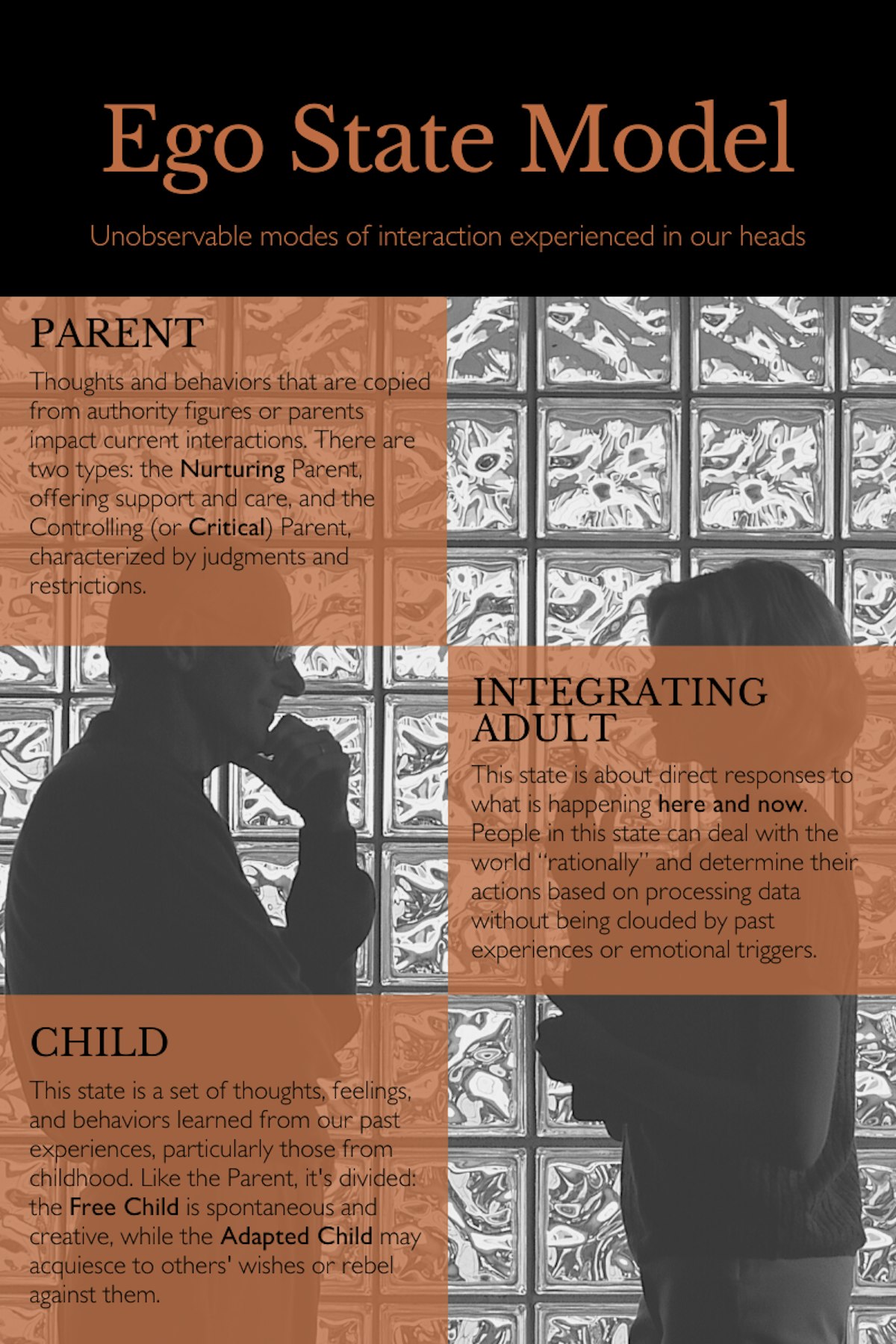
Team communication can make or break a project. How can we communicate with our teammates in a respectful way while keeping each other accountable? Let’s have a look at some examples of dysfunctional communication patterns, reflect, and learn how to do better together.
Team Communication as a Collection of Transactions
There are many ways of looking at human interactions, but one of the most straightforward approaches is something called Transactional Analysis designed by Eric Berne. Transactional analysis originates in the psychoanalytic therapeutic approach, but the application extends to the therapist’s office.
Research shows that when a team is educated on the concepts of transactional analysis, the quality of work life improves, including team communication. The essence of the theory suggests that in a dyadic interaction, meaning one-to-one, both a sender and a receiver have one of the three ego states – Parent, Adult, and Child.
Even without more information on each of these states, you can probably guess that adult coworkers should strive for Adult-to-Adult interactions.
Still, how do these ego states show up in team communication?
Beware! You might recognize yourself in these descriptions and situations, but don’t panic. This doesn’t label you or others as a bad person. In fact, one of the foundational principles of Transactional Analysis is the belief in the inherent “OKness” of every individual.
In other words, everyone has an intrinsic right to exist in the world and be treated with safety and equality.
While someone’s behaviors might be unacceptable or problematic, their fundamental rights and worthiness don’t change. The theory suggests that the communication tendencies we will look at in a minute stem from our childhood. They evolved as strategies to deal with moments when we felt threatened.
However, with awareness, they can be unlearned, and the first step is to notice them in our behavior. With that in mind, let’s learn about the Ego States Model.

Created using canva.com
To put it simply, the Parent state manifests as bossy or protective behavior towards coworkers. This could be someone ordering others around or jumping in to “save” their less experienced colleagues or peers. On the other end, the Child state shows up when someone acts based on their feelings triggered by childhood experience rather than the situation at hand.
Someone in this state can get upset easily, struggle to follow rules, and insist on doing things their own, fun way.
In contrast, the Adult state creates a sense of balance between accountability and respect for individuality. It makes everyone feel heard and valued.
Individuals operating from this state communicate openly, address problems based on facts, and view emotions as informative insights rather than guiding forces.
Note that one person can react from all of these states. What state are you in when you get hungry?
In the next section, we will have a closer look at the most common ineffective interactions to get a better understanding of what can go wrong.
Team Communication: Parent and Child Behaviors
Criticizing Parent: The act of criticizing can often be attributed to a controlling or critical Parent ego state. This state manifests from the lessons and attitudes we’ve internalized from authority figures in our childhood. However, constant criticism, instead of constructive feedback, can create a negative environment.
This mode can demotivate team members, lower their self-esteem, and reduce overall productivity, so it’s better to communicate feedback differently.
Interfering Parent: Over-involvement or micromanagement could again be seen as stemming from the Parent ego state, specifically the controlling aspect. This represents a need to oversee or control others’ actions. This is especially relevant in the manager-report relationship.
Over-involvement in the tasks of your team members and reports and micromanagement stifles their creativity and independence, which can lead to frustration and decreased job satisfaction.
Inconsistent Child: Inconsistency might be seen as stemming from the Free Child or the Adaptive Child ego state, wherein behaviors or responses are not consistent because they’re either acting without restraint (free) or seeking approval (adaptive). Inconsistency in behavior or communication can cause confusion and uncertainty around the person’s behavior.
We are not robots, so nobody expects others to behave the same way all the time. After all, it’s normal to have a bad day.
The problem is when others start to worry about upsetting the ‘child’ and might avoid communicating suggestions for improvements and feedback because it is difficult to predict their reaction.
Over-adapted Child: An over-adapted interaction likely comes from the Adaptive Child ego state, which wants to avoid conflict. This tendency can be a result of earlier life experiences where one learned that being agreeable or avoiding confrontation was the safest or most rewarding reaction.
Some might think, what’s wrong with being nice and polite? Well, excessive compliance or a reluctance to express opinions, objections, or ideas out of a fear of conflict can lead to an imbalance in team communication and hinder the progress of the overadapter.
Oppositional Child: The opposite of the over-Adaptive Child is the rebellious Free Child ego state, which seeks to challenge authority. Thinking about the risks and validating assumptions is crucial in engineering. However, constant contradiction and opposition without valid reasoning can prevent a team from moving forward with decisions and actions.
Reckless Child: Reckless behavior can be attributed to the Free Child ego state. The Free Child acts on impulse without considering consequences or boundaries, much like a child who knows little about societal rules. Impulsiveness and disregard for rules, protocols, or the feelings of others can create chaos and potential interpersonal conflicts.
The good news is that we can switch between these ego states depending on the situation, our mood, or other influencing factors. It’s also worth noting that the Parent and Child ego states can have both positive and negative impacts on team communication.
For example, the Free Child can be creative and spontaneous, and thus, generate energy in the team, but recklessness can negatively impact the growth and learning of the one enacting such behavior.
The Adaptive Child can be cooperative, but their over-compliance might stop them from voicing concerns. Consequently, the team can choose the wrong direction.
Preventing Ego-State Conflicts in Team Communication
As you might remember from the introduction, training in Transactional Analysis can help us recognize our ego states and understand the dynamics at play during interactions. We can consciously choose to operate from our Adult ego state and encourage more effective and balanced team communication.
But how does one operate from the Adult state? The recipe is short:
- Practice self-awareness: Understanding one’s own typical ego states and how they influence interactions is a crucial step. Start by reflecting on your interactions in the past two weeks. Which ego states do you find yourself in? Try to journal or note down situations, reactions, and feelings to track these patterns.
- Manage your Self: Learning to transition into the Adult ego state, even when emotionally triggered is the ultimate dream in Transactional Analysis. When you catch yourself slipping into a non-Adult ego state, especially during stressful situations, take a deep breath and ask yourself, “What would the OK part of me say or do?” Try grounding yourself by counting to ten or taking a short walk, to help transition into your state of “OKness.”
- Manage your relationships: Navigating interactions with others with empathy and understanding. We are often unaware of what our coworkers around us go through so avoid judging others as well as yourself for what you observe. Imagine a team member acts from a critical Parent state.
As you notice their Ego state, you realize that at least one of you needs to communicate from an Adult state to avoid conflict. What now? Take a deep breath, try to strip down the critical language, and respond to the core of what is being communicated with arguments. You might want to provide feedback too, if the behaviors occur frequently.
Easier said than done!
I said the recipe is short, not that it is easy. We cannot change how others communicate, but by distinguishing between a person’s core value and their actions, we can focus on the problem at hand which helps avoid conflicts. In the same way, we can reflect on our own behavior, and interaction by interaction, we can improve our communication without judgment.
If you are becoming a fan of Transactional Analysis and find yourself yearning to learn more about individual or team communication, try to get your hands on Working Together.
This article was originally published by Nikola O. on Hackernoon.




